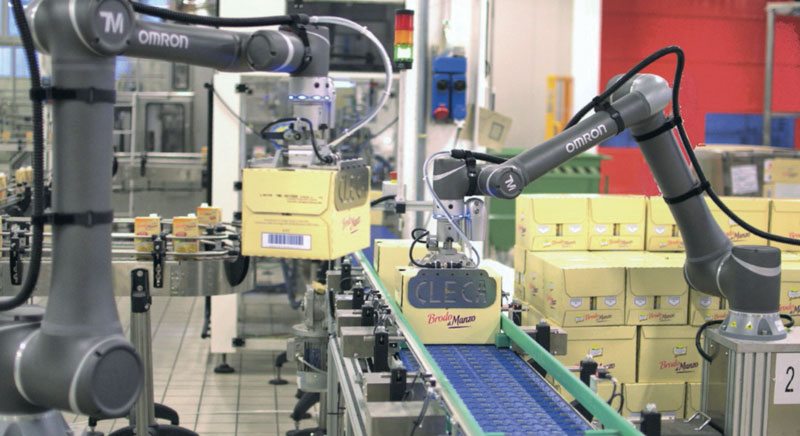Human-Robot Collaboration Makes Products Better
Cleca, a Mantuan food products company, has chosen to insert two OMRON’s cobots at the end of the line, with the aim of increasing plant automation and improving the work of its employees. The pair of robots is able to work side by side with human operators in a safe and efficient way, thus optimising production and creating real harmony between the machine and man.
The SINIC theory (cyclical evolution from innovation to need), developed by the founder of OMRON Kazuma Tateishi, has the aim of aligning the company’s strategy with the future needs of a modern society. According to this theory, the current era represents the stage of interaction and collaboration between people and machines. In today’s factories, robotics, the Internet of Things (IoT) and Artificial Intelligence are already being combined for the purpose of acquiring data efficiently from a production site and enabling robots to work together with people in perfect harmony. From automation where the operators’ activity is physically separated from machines, new and efficient scenarios are now arising due to collaboration between people and robots, resulting in increases in productivity.

To make this collaboration possible, automation must meet specific requirements for safety, ergonomics, ease of use and rapid implementation. Traditional robotics may not always be able to meet some of these requirements, and this has resulted in a move that goes beyond the current process-driven integration. Cobots are leading the way in this paradigm shift, by connecting people with machines in automated processes. Cobots have created a meeting point between man and machine. This flow achieves the goal of efficient automation and relieves operators from strenuous and repetitive tasks, whilst leading to the production of goods of the highest quality. The use of cobots in food and beverage manufacturing brings many advantages in terms of savings and efficiency, for both large and small manufacturing companies: automation is a cost-effective way of reducing waste and human errors, leading to higher quality products.
A pair of cobots to improve productivity
This move towards greater automation is because in today’s environment, food production processes are in many ways as important as the product itself. Consumers are asking more and more questions about the supply chain; the resources consumed by the industry; and the working conditions and safety of the workers. Cobots can take a vital role in helping companies to adapt to the changes in the current landscape; and how companies can also make the technological and cultural adaptations needed in response to the fifth industrial revolution. A company that has chosen this path to the future is Cleca, specialised in the production of food such as puddings, cakes, bakery products and much more, with the integrations of two OMRON’s collaborative robots TM12 series for its set-up and shipping operations. This decision of deploying a pair of Omron TM12 cobots at the end of the packaging line was received very well by the operators, who soon noticed a clear improvement in their work conditions. They experienced a reduction in repetitive operations (as these were delegated to the machine), as well as improved change-over times. As any downtime can be expensive, the OMRON cobots needed to be able to be operational rapidly, to ensure business continuity. Fortunately, they are equipped with plug-and-play software which makes them ready for use immediately after they have been installed. This is an intuitive process that allows operators to perform rapid programming activities during start-ups and production changes, which in turn ensures production continuity as quickly as possible. The operators at Cleca work with smart systems with which they can interact and which they can easily operate without the need for long training. Programming is simple and does not require an additional keyboard or push buttons.

Security and Industry 4.0
The TM12 cobot, a machine with a payload of 12 kg and reach of 1,300 mm, is equipped with an integrated vision system: the built-in camera locates objects in a wide field of vision, while lighting for image enhancement ensures image recognition in almost all conditions. The vision system improves the reliability, uniformity, and accuracy of the positioning of items. It also includes features such as pattern-matching, barcode reading and colour identification, enabling the company to carry out inspection, measurement and sorting activities at no additional cost or effort. The harmony between people and machines enables them to work side-by-side. However, they still need to meet high safety standards: the OMRON’s cobot was designed to promote a safer working environment; safety regulations require machine manufacturers to carry out a project-based risk assessment in the design and construction phase, even if the machine is produced for internal use. This risk assessment helps Cleca to comply with the machinery directive 2006/42/EC and the safety requirements of the technical standard ISO 10218 and the technical specification ISO / TS 15066. The OMRON’s cobots do not require protective fencing, due to their integrated safety functions and can be installed without resorting to cumbersome (and expensive) investments in hardware and software. The TMFlow programming environment, based on flow charts, enables high application flexibility, allowing production processes to be quickly reconfigured. The introduction of OMRON’s cobots at Cleca coincided with the implementation of key automation solutions relating to Industry 4.0, including the connection and interface with the factory’s manufacturing execution system (MES). The integration of the collaborative cell and the machines present in the plant was made possible by the Ethernet communication integrated between Cleca’s various OMRON programmable logic controllers in its San Martino dall’Argine (MN) plant. The increase in productivity and process efficiency achieved by using the cobots, combined with the reduction of indirect costs, will enable CLECA to achieve a return on investment (ROI) in less than a year from the start-up of the collaborative cell.

